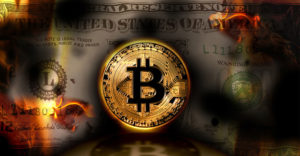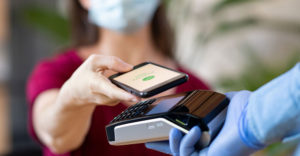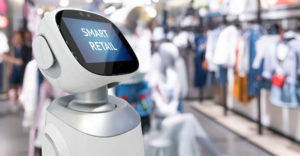Thanks to two years of pandemic-induced e-commerce and changes in how consumers behave with in-store transactions, the gap between cashless and contactless money is closing.
While much of the global economy is steadily transitioning to commerce without paper cash, some consumers struggle with concerns about leaving paper money behind.
Vendors worry less about the disappearing dollar as they focus on handling emerging cryptocurrencies. Add to these worries a litany of fintech solutions moving full steam ahead.
Many financial services are already in the marketplace, preparing for what has been classified as a cashless society. Warnings mount that consumers must be better prepared with technology before the paradigm shift to cashless money progresses further.
From pre-pandemic 2020 to today, cashless businesses have more than doubled in the U.S., Australia, Canada, the U.K., and Japan.
Multiple Variables in Play
Is contactless payment safer? Will consumers find it more convenient? Will shoppers accept smart devices handling transactions in the absence of carrying cash and plastic cards in their wallets?
The push for this transition is not only coming from germ-fearing shoppers and front-line store workers. Businesses are also driving the trend to pay without paper money.
One thing is for certain, according to money and fintech experts. We are heading toward a cashless society. Infrastructure is developing to fully support new payment standards.
“When these systems are truly ready, they will not need to be learned or understood. They will just be how everything gets done,” Lee Hansen, CEO at fintech provider Byte Federal, told the E-Commerce Times.
Transition to Contactless and Cashless
The concept of cashless and contactless payments began as separate use cases but now share a single goal. Early use cases started as an attempt to pay for access to services and product purchases quickly and easily without interfacing with cashiers, suggested Greg Cohen, commerce and payments technology firm Fortis Payment Systems.
“Contactless has really morphed into the natural evolution of what I kind of call the embedded commerce experience,” he told the E-Commerce Times.
From a business standpoint, it speeds up receivables tremendously. It is about creating a more improved customer experience.
To illustrate his point, Cohen referred to what is now spreading from physical stores such as Amazon Go to other supermarkets and retail outlets.
With a shopper already in the store, why should there be this thing about pulling a card out and dipping a card? Why do you have to wait in line? he asked.
You walk in, and cameras grab your items. You walk out with your stuff.
In that scenario, the camera connects with optical sensors to record what the shopper puts in the cart. The scanner makes facial recognition and reads the payment information from the consumer’s registered identity and payment card.
“Those are the kinds of the new world of contactless experiences,” he said. “Apple [recently] announced that it will be embedding contactless capabilities into iPads so that you can get rid of terminals.”
Pain Point Killer
Cashless payments go beyond not carrying cash in your wallet. It smooths out the payment situation between the customer and the business.
With cashless payment systems, both consumers and businesses can make purchases and payments the same way, provided their ID and bank credentials are on file, offered Cohen.
The payment process goes from sending an invoice and waiting 30 or 60 days for the payment to receiving payment immediately.
“It is this natural evolution of the embedded commerce that drives better experiences. It removes the friction at the point of sale in the physical world, the mobile world, and the e-commerce world,” Cohen explained.
Businesses could more conveniently offer financing, too. Let’s say you are buying $200 worth of goods. If it was convenient, you might instead buy $400 because they offer buy now, pay later options, or point of sale financing in the transaction, he added.
“So the business wins generally because of a better experience, not necessarily a lower fixed cost,” he said.
Growing Acceptance
Consumers have become more receptive to cashless and contactless payments after two years of shifting from in-person transactions to online ordering and online banking during the pandemic. It is easy for shoppers to buy into the new processes as it does not cost them.
“Generally speaking, yes,” added Byte Federal’s Hansen. “However, this trend away from cash started long ago with credit cards. The crypto tech stack has certainly accelerated this transition,” he confirmed.
That longer adoption process tells the tale of overlapping technologies, observed Fortis’ Cohen. Consumers have generally adopted it in specific use cases.
“It has been a longer adoption. We joke today that the mag stripe technology was a 40-year-old technology replaced with EMV [Europay, Mastercard, and Visa]. That was a 20-year-old technology, which is replaced by contactless, a 10-year-old technology,” he quipped.
Each credit card today has contactless capabilities embedded because consumers are used to using a card, and not everywhere accepts it. The migration of only making contactless payments via phone is a natural evolution, noted Cohen.
Challenges Remain
One of the major obstacles to more adoption of cashless payments is solving the very fragmented ecosystem, said Cohen. This is especially the case in the United States, with many different point-of-sale systems. He expects a long period of dealing with different point of sales systems before the retail industry succeeds in standardizing the process.
Part of the solution for solving the ecosystem issue is businesses partnering with technology providers. That is critical, Cohen noted. Investing in technology with technology partners will future-proof a business’s point-of-sale machinery.
“Even B2B clients now have direct-to-consumer or direct-to-customer websites where they may have only gone through distribution in the past.
Ultimately, suggested Hansen, full adoption could fall to the next generation. Technology-friendly processes are a big part of transitioning to a cashless economy.
“The diehard cash user is never going to change. Most consumers are completely unaware of the underlying tech that makes cashless markets safe from discrimination, inflation, and other nefarious manipulations,” he said.
Banks Pivotal to Full Adoption
Banks, on the other hand, are under attack by financial technology providers, according to Cohen.
Financial technology providers are offering businesses, retailers, and consumers loans, bank accounts, credit cards, and other enticements for using a specific platform like Square Cash and PayNow.
Banks must come up with a whole new arsenal of solutions to keep up with where the technology providers are going, Cohen suggested.
“So, the banks are an interesting, kind of pivot point of how they can architect their own ecosystems to keep up with the fintechs,” he predicted.



























































Social Media
See all Social Media